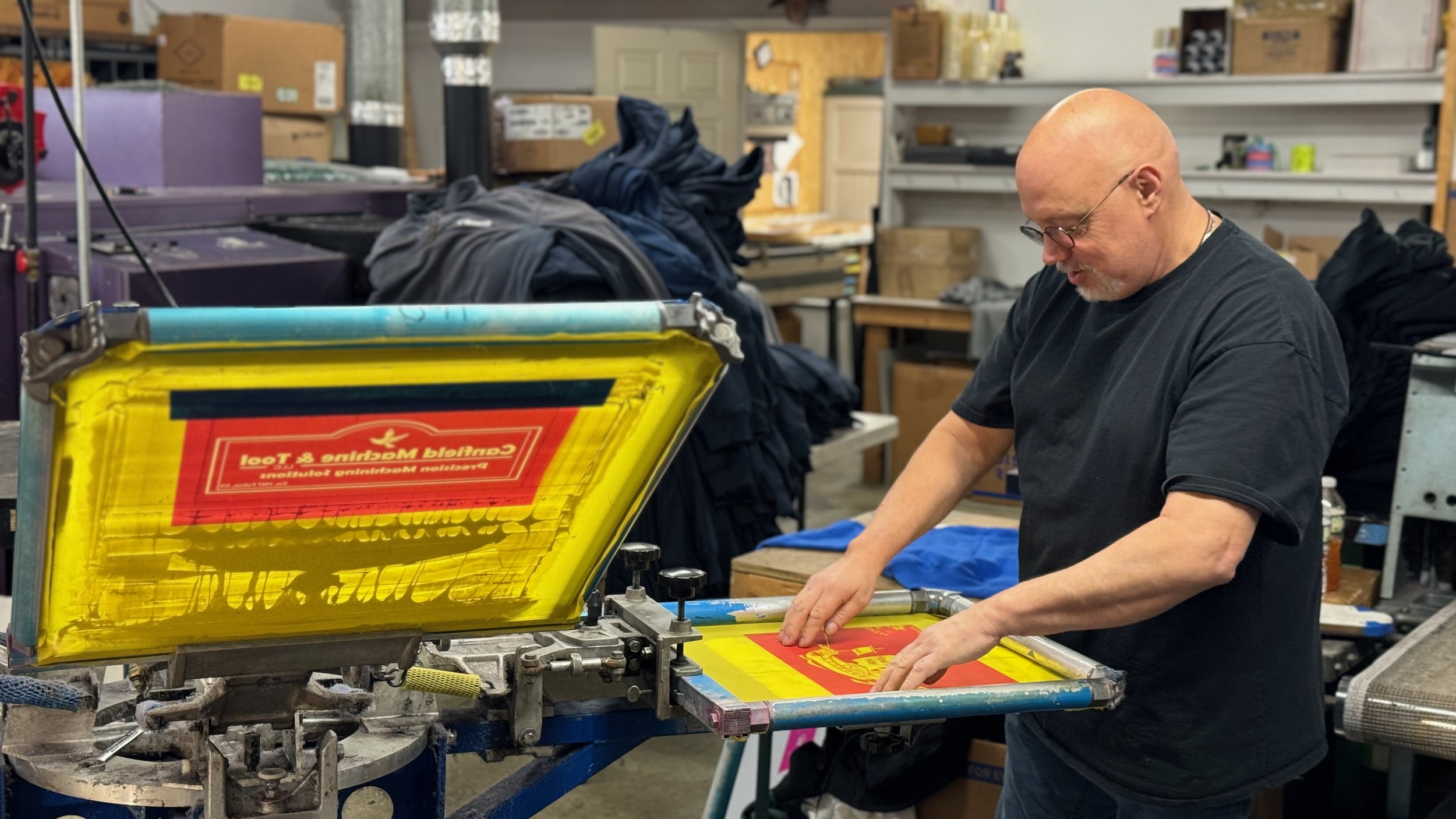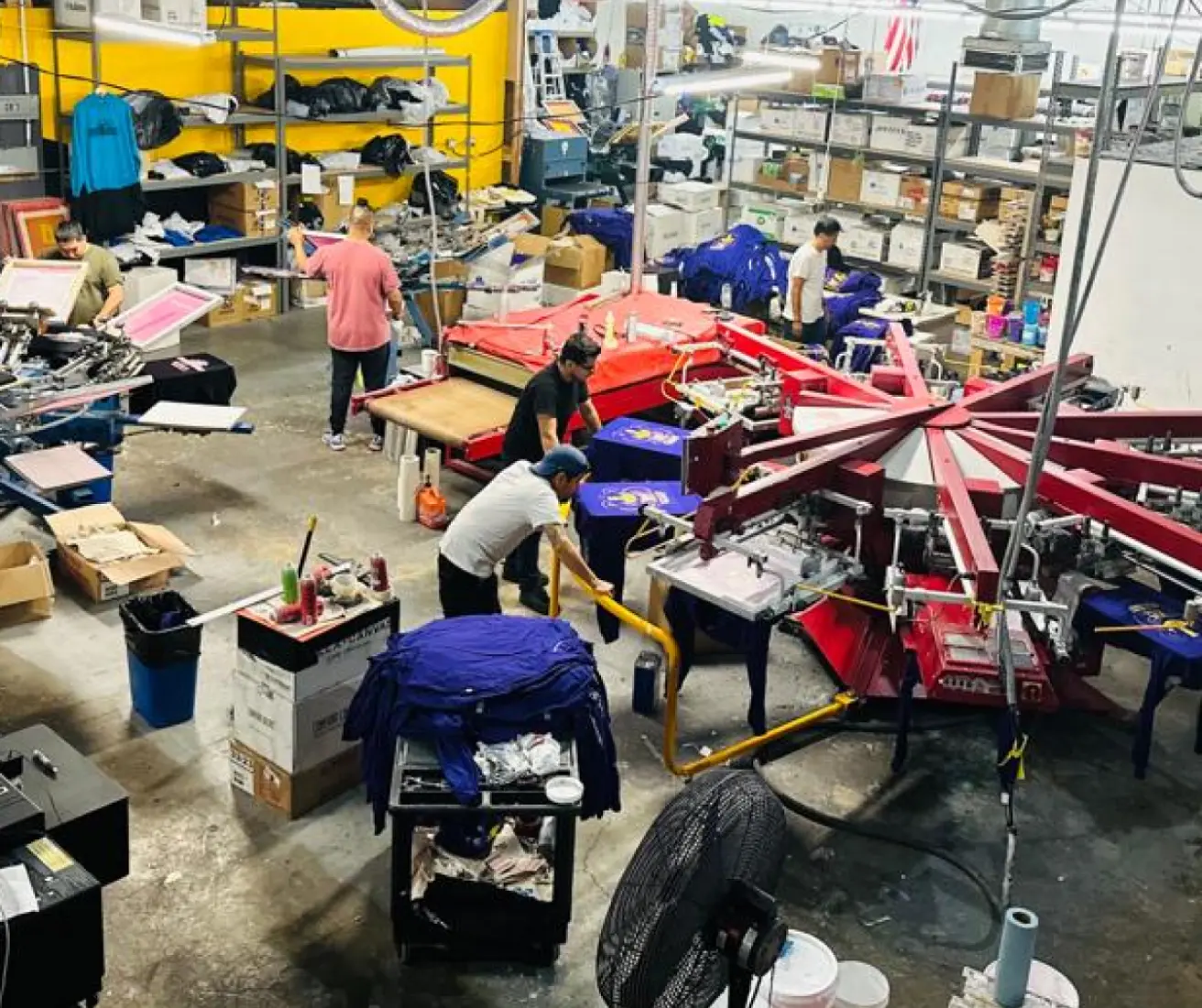Display Printing Uncovered: Every Little Thing You Need to Learn About T-Shirt and Garment Printing Strategies
If you have actually ever before wondered exactly how those vivid layouts finish up on your preferred tees, you remain in the appropriate area. Display printing is a remarkable approach that incorporates art with strategy, supplying limitless possibilities for creative thinking. Understanding the principles, from equipment to ink choices, can greatly affect your outcomes. Prepared to check out the vital aspects that make display printing an art type? Allow's discover the information that can raise your tasks.
The Essentials of Screen Printing: How It Functions
When you dive right into screen printing, you'll find it's both a science and an art. At its core, screen printing includes developing a pattern, or display, that enables ink to pass through just in particular locations.
Placement the screen over the textile, then use a squeegee to push ink through the screen onto the garment. Each step is essential, and mastering them will elevate your display printing abilities, transforming straightforward garments into unique, expressive pieces.
Sorts Of Display Printing Methods
When you understand the fundamentals of display printing, it's time to check out the various techniques that can elevate your styles. One popular method is conventional screen printing, where ink is pushed through a stenciled display.
If you're intending for fine details, consider discharge printing. This strategy gets rid of dye from the material, leaving a soft, vintage appearance. An additional choice is plastisol printing, known for its longevity and dazzling shades, making it a preferred for many brands. Experiment with halftone printing to develop slope results and complex designs. Each strategy has its special charm, so don't think twice to try them bent on discover what fits your design best!
Vital Equipment for Screen Printing
To attain sensational lead to screen printing, having the ideal devices is essential. You'll require a tough screen printing structure, which holds the mesh that moves your layout onto the garment. Next off, invest in top quality mops; these are important for using ink evenly throughout the display. You'll also need an excellent exposure system to develop your displays, as well as a washout cubicle for cleansing them after use. A reliable heat resource, like a conveyor dryer or heat press, is important for healing your prints to assure durability. Do not neglect a correct office, equipped with tables and storage for your materials. Safety gear, such as handwear covers and masks, will maintain you risk-free from chemicals and inks. With the right devices, you'll be well on your way to creating professional-quality prints.
Selecting the Right Inks and Materials
When picking inks and products for screen printing, you need to take into consideration the kind of ink that functions ideal for your task. Think of textile compatibility to ensure your styles look wonderful and last long. Explore eco-friendly ink options to make your printing process extra lasting.
Kinds of Screen Inks
Choosing the ideal screen ink is necessary for achieving vibrant, durable prints that meet your project's demands. There are a number of types of screen inks to examine. Specialty inks, such as metallic or glow-in-the-dark, can include unique results to your layouts.

Fabric Compatibility Considerations
Comprehending fabric compatibility is important for attaining high-quality display prints, especially since various products respond distinctly to different inks. When choosing inks, take into consideration the material type-- cotton, polyester, or blends. For cotton, water-based inks work well, supplying gentleness and breathability. Polyester, on the various other hand, commonly needs plastisol inks for far better bond and lively shades. If you're publishing on blends, you could require to make use of a mix of both kinds. Constantly evaluate your inks on example textile to assure they stick correctly and preserve shade stability. In addition, bear in mind that fabric weight and appearance can affect the final result, so choosing the best ink and material combo is vital for your project's success.
Eco-Friendly Ink Options
Environment-friendly inks are becoming a popular option for display printers who want to minimize their ecological influence while keeping top quality. When selecting inks, consider water-based inks, which are much less dangerous and simpler to cleanse up contrasted to traditional solvents.
Additionally, look for inks made from eco-friendly sources, such as soy or vegetable-based options. By picking the ideal inks and products, you'll not only create stunning layouts but also contribute to an extra sustainable printing procedure. Make the switch, and your prints will certainly reflect your commitment to the atmosphere!
Preparing Your Layout for Screen Printing

Submit Style Demands
To guarantee your layout looks lively and sharp on textile, you'll need to pay close focus to submit layout demands for display printing. Begin with vector files like AI or EPS, as they can be scaled without losing top quality. If you use raster photos, go with high-resolution documents, such as TIFF or PNG, preferably at 300 DPI. Avoid using JPEGs, as they can shed clearness when visit the site resized. Make sure your style has a transparent history to protect against unwanted white edges on your prints. Ultimately, keep color modes in mind; CMYK is standard for display printing, so convert your RGB creates as necessary. By adhering to these guidelines, you'll establish your art work up for an effective print.
Color Separation Techniques
Shade separation is an essential action in preparing your style for display printing, and grasping it can significantly boost your print top quality. You'll need to damage your design right into individual shades, as each color calls for a separate display during printing. This accuracy not just ensures accurate color depiction but likewise simplifies the printing process.
Resolution and Dimension
Achieving the very best cause display printing begins with ensuring your layout has the right resolution and dimension. Preferably, your artwork must go to least 300 DPI (dots per inch) for sharp, clear prints. Your final item could look pixelated and less than professional. if you use lower resolution.
When it involves dimension, consider the dimensions of your print area. pop over here Layout your art work to match the final print dimension, preferably creating it in the real dimensions you'll be publishing. By doing this, you'll prevent any unanticipated scaling concerns.
Always check your style in both vector and raster layouts. Vector graphics can be scaled without losing high quality, making them ideal for screen printing. Preparing correctly will assure your design looks outstanding on every garment!
Step-by-Step Display Printing Refine
Display printing is a vibrant procedure that permits you to develop vivid designs on different surface areas. To obtain started, you'll require a screen, solution, and your selected ink.
After rinsing the unexposed emulsion, your display is ready. Set it up on your printing surface and straighten your garment below it. Put ink onto the display and use a squeegee to press the ink with the pattern onto the textile. Lift the screen thoroughly and let the print dry. Heal the ink making use of heat to guarantee sturdiness. That's it! You have actually effectively screen published your design.
Tips for Successful Display Printing Projects
While you're diving into your display printing projects, remember that preparation is essential to success. Beginning by gathering all check my reference your products-- inks, garments, squeegees, and displays. A clean work space aids stop unwanted errors, so clean up before you begin.
Following, confirm your art work is high-resolution and appropriately sized for your garment. Test your screen for correct exposure and tidy it thoroughly to prevent spots. When blending your inks, comply with the maker's standards to achieve the best consistency.
During printing, use also pressure with your squeegee for constant results. Don't hurry; take your time to validate each print meets your requirements. After printing, allow your garments dry totally prior to handling or packaging them.
Last but not least, constantly maintain an example of your work for future reference. This way, you can evaluate your progression and improve your methods gradually. Satisfied printing!

Frequently Asked Questions
How much time Does It Take to Set up a Screen Printing Task?
Setting up a display printing work commonly takes around half an hour to an hour. You'll prepare the displays, mix inks, and adjust the press. The moment differs based on complexity and experience, so remain arranged!
Can I Print on Different Fabric Keys In Making Use Of the Very Same Strategy?
Yes, you can publish on different fabric kinds utilizing the very same strategy, however you'll need to readjust your settings and inks. Some materials absorb ink in a different way, so experimenting guarantees the very best outcomes for every material.
What Are Usual Errors to Avoid in Display Printing?
When screen printing, avoid usual mistakes like making use of the wrong ink, disregarding proper direct exposure times, or missing pre-press checks. Constantly check your configuration and maintain tidy screens to ensure top quality results each time.
How Can I Appropriately Clean and Keep My Screen Printing Tools?
To appropriately tidy and keep your screen printing devices, you need to routinely clean screens with proper solvents, check mops for wear, and ensure all devices are stored dust-free and completely dry. Consistency protects against costly repair work and enhances performance.
Is Screen Printing Eco-friendly Contrasted to Various Other Approaches?
Screen printing can be extra ecologically pleasant than other methods, particularly if you make use of water-based inks and eco-conscious materials. By picking sustainable materials and techniques, you reduce waste and reduce your effect on the earth.
Screen Printing Uncovered: Whatever You Required to Know Concerning T-Shirt and Garment Printing Techniques
At its core, screen printing involves producing a pattern, or display, that permits ink to pass through only in certain locations. Setting the display over the textile, then use a squeegee to press ink via the display onto the garment. One prominent method is conventional screen printing, where ink is pushed via a stenciled screen.When choosing inks and materials for screen printing, you need to take right into account the type of ink that works finest for your job.
Comments on “Vintage Style Silk Screen Printing for Retro Fashion”